As the great Stan Lee might say, “Welcome back, True Believers!” Unless this is the first time you’ve fallen into the my dastardly clutches, you'll already know that Living Ink is a weekly series in which I outline a character’s powers, personality, and comic book history, and then discus how UDE infused all of that flavor into the little bits of cardboard that we call Vs. System.
If you missed it, last week’s article looked at everyone’s favorite wall-crawler and the whopping twelve versions of him that currently exist in our game. This week, we’re going to see how the other half lives.
A few years ago, I was working as a newspaper journalist and a close friend of mine named Chris worked in a laboratory. Being the geeks that we were (and continue to be), we inevitably got into a debate about which one of us would be more likely to develop super powers. I argued that there was an impressive list of top shelf super heroes who worked in the newspaper industry. Worst-case scenario, I should be a super hero’s best pal. Chris argued that many heroes and villains obtained their extraordinary abilities as a result of laboratory accidents or other scientific endeavors. I countered that as a journalist, it was highly likely that I would also be present at any such accident, covering it for the newspaper. I’d still get my powers; he’d naturally become a villain (due to his poor moral fiber) and most likely be my arch nemesis. Thinking back on this, I was reminded of the relationship between Peter Parker and this week’s subject, Dr. Otto Octavius, better known to fanboys worldwide as Dr. Octopus.
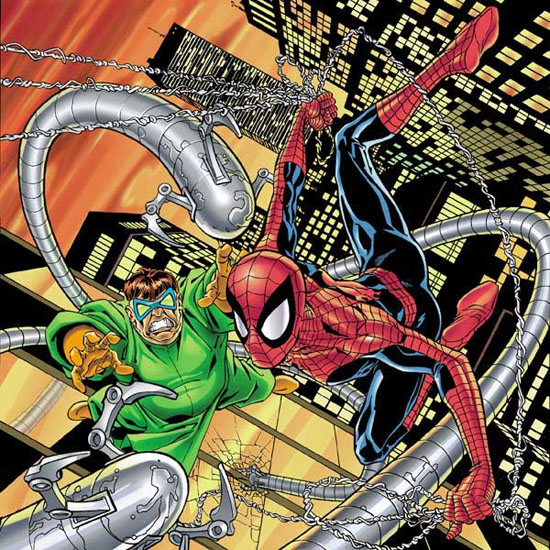
Dr. Octopus is arguably Spider-Man’s greatest nemesis (although Green Goblin, Norman Osborn might have something to say about that). He first appeared in Amazing Spider-Man #3 way back in July 1963, and was the fourth of Spidey’s rogues' gallery to be introduced (following Chameleon, Dmitri Smerdyakov; Vulture, Adrian Toomes; and Tinkerer). While he has a tubby, relatively weak physique and severe nearsightedness, Doc Ock’s four mechanical tentacles give him great reach and potency in a fight. Historically, he is one of Spidey’s most dangerous foes, beating the hero so savagely in his first appearance that the web-slinger considered immediate retirement from the spandex crowd.
By way of background, Otto grew up with a violent and abusive father and a somewhat coddling mother. This resulted in him being rather timid and socially awkward at school. His aptitude for science became a key focus, as he swore never to be like his father. Keen observers might notice that with the exception of the destructive family life, elements of Otto’s story are reminiscent of Peter Parker’s personal history. Octavius grew up to be a talented and highly regarded nuclear physicist, inventor, and lecturer. He then turned his genius to inventing a set of mechanical limbs, which he used to manipulate (with either great precision or considerable strength) objects he was studying while avoiding exposure to deadly radiation (see Doc Ock’s Lab). Perhaps predictably, there was an explosion during one of his experiments that fused this apparatus to his body and exposed Otto to intense radiation. This radiation mutated Octavius’s brain, enabling him to control the tentacles with the power of his mind. Even when, in a later story, the mechanical arms were surgically removed, Otto retained the power to control them telepathically. While his mind may have been fragile to begin with, the accident drove Dr. Octavius completely over the edge. He became nothing short of a meglomaniacal mad scientist. He look the nom de guerre Dr. Octopus and turned to a life of crime, although personal prosperity regularly went by the wayside as a result of an obsession with proving his genius and besting Spider-Man at all costs.
Dr. Octopus is a prime example of a science villain, while Spider-Man himself can be viewed as a science hero. But where Peter Parker turned a radioactive spider bite and the Tragic Loss of his father figure into the catalyst for one of the greatest heroic careers in all of comicdom, Otto Octavius allowed his misfortune to twist him (glossing over likely brain damage for the sake of my argument).
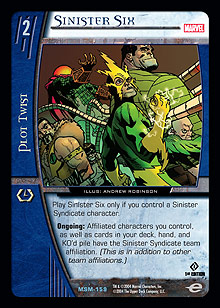 Showing that he is more of a team player than most villains are, Dr. Octopus was the leader of the original Sinister Six. After a series of beatings at the hands of Spider-Man, Doc Ock realized that he needed help to defeat his nemesis. He contacted every known villain Spider-Man had ever faced, but only five signed up. The first incarnation of the Sinister Six was comprised of Vulture; Electro, Maxwell Dillon; Kraven the Hunter; Mysterio, Quentin Beck; and Sandman, William Baker. The Green Goblin refused to join because he didn’t want to share the glory of defeating the Amazing Spider-Man. Doc Ock later founded his own version of the Masters of Evil and attempted to invade the Avengers’ headquarters. This, of course, turned out to be a short-lived endeavor.
Showing that he is more of a team player than most villains are, Dr. Octopus was the leader of the original Sinister Six. After a series of beatings at the hands of Spider-Man, Doc Ock realized that he needed help to defeat his nemesis. He contacted every known villain Spider-Man had ever faced, but only five signed up. The first incarnation of the Sinister Six was comprised of Vulture; Electro, Maxwell Dillon; Kraven the Hunter; Mysterio, Quentin Beck; and Sandman, William Baker. The Green Goblin refused to join because he didn’t want to share the glory of defeating the Amazing Spider-Man. Doc Ock later founded his own version of the Masters of Evil and attempted to invade the Avengers’ headquarters. This, of course, turned out to be a short-lived endeavor.
Perhaps the weirdest storyline involving the not-so-good doctor was when he became personally involved with Peter Parker’s Aunt May, May Parker. They were even engaged to be married (see The Amazing Spider-Man Vol. 1 #131, published circa 1974). “Uncle Otto?”
None of the above is to suggest that Doc Ock is all bad. He has, on a few occasions, performed deeds that benefited humanity, including helping Spider-Man to avert nuclear disaster in one story. During the Clone Saga, Dr. Octopus even saved Spidey from certain death at the hands of the Vulture. Sure, it was part of a larger, not-so-benevolent plot, but a little bit of bad shouldn’t erase all of a man’s good deeds, right? Nor does any good deed go unpunished—this storyline ended in Otto’s demise. Luckily, though, he was later ressurrected by the The Hand (see The Amazing Spider-Man #426-428, published circa 1997).
Most recently, Dr. Octopus has been seen throwing a force-five hissy fit, rampaging through New York City when Spider-Man revealed his secret identity at a press conference in Sensational Spider-Man #28 (during the early stages of the Civil War storyline). He was flabbergasted that it was a pimple-faced teenager who had been beating the tar out of him all these years, and kicking himself because he once unmasked Spidey to find Peter Parker but had dismissed the revelation as a ploy because Spidey was severely weakened at the time. Naturally, Doc Ock was once again defeated by the web slinger and sent to a super-villain detention facility. There, he was allegedly rehabilitated and is now one of the ex–super villains tasked with hunting down the renegade heroes in the Civil War storyline.
In a situation that is sure to be an affront to his ego, Dr. Octopus currently has only three Vs. System versions (while that pesky insect, Spider-Man, has a full dozen). These incarnations include two from the Web of Spider-Man expansion and one from the brand-spanking-new Marvel Team-Up set. Let’s take a look at those character cards.
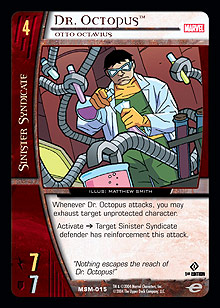 Dr. Octopus, Otto Octavius is the smallest version of the character in Vs. System. As I explained last week, when a character has multiple versions, the cards with lower costs traditionally represent that character earlier in his or her career. So, Otto here can be viewed as Dr. Octopus early in his criminal career. He hasn’t had his powerful tentacles for long and is shown in Matthew Smith’s artwork to be hard at work in his lab. More than in any other incarnation, Otto Octavius is portrayed here as a science villain. Otto has two powers: a triggered effect and an activated ability. The former allows Dr. Octopus to attack one character while tying down another, which is an effective representation of his ability to direct his different tentacles to engage and immobilize multiple opponents (see Pinned). It also reflects Otto’s scheming mind as he manipulates his opponents for an as-yet-unrevealed strategic purpose, whether stalling for his master plan, breaking reinforcement channels, or sending in one of his teammates to kick a guy while he’s down with a Crushing Blow. Meanwhile, Otto’s activated ability again represents his reach, as he can use one of his mechanical arms to reinforce a Sinister Syndicate teammate even when he isn’t in the required adjacent support row position. Also, it demonstrates the Doctor’s leadership capabilities: he works to protect his teammates, even if he’s really only concerned with how such situations impact him personally.
Dr. Octopus, Otto Octavius is the smallest version of the character in Vs. System. As I explained last week, when a character has multiple versions, the cards with lower costs traditionally represent that character earlier in his or her career. So, Otto here can be viewed as Dr. Octopus early in his criminal career. He hasn’t had his powerful tentacles for long and is shown in Matthew Smith’s artwork to be hard at work in his lab. More than in any other incarnation, Otto Octavius is portrayed here as a science villain. Otto has two powers: a triggered effect and an activated ability. The former allows Dr. Octopus to attack one character while tying down another, which is an effective representation of his ability to direct his different tentacles to engage and immobilize multiple opponents (see Pinned). It also reflects Otto’s scheming mind as he manipulates his opponents for an as-yet-unrevealed strategic purpose, whether stalling for his master plan, breaking reinforcement channels, or sending in one of his teammates to kick a guy while he’s down with a Crushing Blow. Meanwhile, Otto’s activated ability again represents his reach, as he can use one of his mechanical arms to reinforce a Sinister Syndicate teammate even when he isn’t in the required adjacent support row position. Also, it demonstrates the Doctor’s leadership capabilities: he works to protect his teammates, even if he’s really only concerned with how such situations impact him personally.
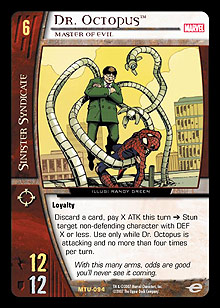 Dr. Octopus, Master of Evil is the newest kid on the block, arriving as a Marvel Team-Up 6-drop. But based on the recruitment cost, artwork, and version of this card, I believe it portrays Doc Ock at a period somewhere between the two other incarnations. As previously mentioned, Dr. Octopus formed a version of the Masters of Evil in Guardians of the Galaxy #28, published in September 1992. While his costume in that story reverted to a jumpsuit–type outfit similar to that shown on the Otto Octavius version, it was common around this time for Doc Ock to be shown dressed in a suit (sometimes green, other times white or gray). Artist Randy Green also gives us an image of Otto in a rare—and likely fleeting—moment of triumph. Every villain should have his day, in my opinion. Like all other incarnations of Dr. Octopus in Vs. System, Master of Evil represents Otto’s ability to lash out at multiple opponents with his tentacles, although he is restricted by the requirement to sacrifice ATK to achieve this. If nothing else, it demonstrates that Dr. Octopus is a bit of a bully, as this power is most effective against smaller characters. It is interesting to note that this version is the only incarnation of Doc Ock with range. I think Dr. Octopus’s powers justify this capability (as with Mr. Fantastic, Stretch), and the fact that Master of Evil has it is just a cherry on top of what I feel is an excellent, flavorful representation of the character.
Dr. Octopus, Master of Evil is the newest kid on the block, arriving as a Marvel Team-Up 6-drop. But based on the recruitment cost, artwork, and version of this card, I believe it portrays Doc Ock at a period somewhere between the two other incarnations. As previously mentioned, Dr. Octopus formed a version of the Masters of Evil in Guardians of the Galaxy #28, published in September 1992. While his costume in that story reverted to a jumpsuit–type outfit similar to that shown on the Otto Octavius version, it was common around this time for Doc Ock to be shown dressed in a suit (sometimes green, other times white or gray). Artist Randy Green also gives us an image of Otto in a rare—and likely fleeting—moment of triumph. Every villain should have his day, in my opinion. Like all other incarnations of Dr. Octopus in Vs. System, Master of Evil represents Otto’s ability to lash out at multiple opponents with his tentacles, although he is restricted by the requirement to sacrifice ATK to achieve this. If nothing else, it demonstrates that Dr. Octopus is a bit of a bully, as this power is most effective against smaller characters. It is interesting to note that this version is the only incarnation of Doc Ock with range. I think Dr. Octopus’s powers justify this capability (as with Mr. Fantastic, Stretch), and the fact that Master of Evil has it is just a cherry on top of what I feel is an excellent, flavorful representation of the character.
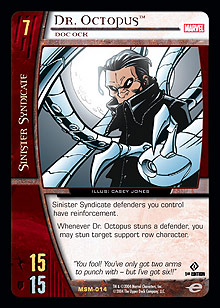 Dr. Octopus, Doc Ock is the 7-drop version of the character from the Web of Spider-Man set. Here we see a much bigger, meaner, and scarier version of the villain. Visually, this card sports the Humberto Ramos redesign that debuted in Spectacular Spider-Man Vol. 2 #6, published in November 2003. I particularly like the eerie full moon that illustrator Casey Jones used in the background. Interestingly, Doc Ock’s 15 ATK / 15 DEF stats mean that if he and Spider-Man, The Amazing Spider-Man (14 ATK / 16 DEF) were to meet in combat, as I’m sure they did regularly after players purchased the Spider-Man vs. Doc Ock starter, neither would be able to stun the other naturally. While Spidey usually winds up victorious whenever these characters meet in the comics, this dynamic illustrates that the two characters are closely matched. The 7-drop Doc Ock’s powers are essentially souped-up versions of those seen on the 4-drop—he gives all Sinister Syndicate teammates reinforcement at no cost and can outright stun a second character during a successful attack if the opponent does not form up specifically to avoid it. Finally, Dr. Octopus’s genius-level intellect is highlighted in the flavor text, where he points out that six arms are better than two. Classic.
Dr. Octopus, Doc Ock is the 7-drop version of the character from the Web of Spider-Man set. Here we see a much bigger, meaner, and scarier version of the villain. Visually, this card sports the Humberto Ramos redesign that debuted in Spectacular Spider-Man Vol. 2 #6, published in November 2003. I particularly like the eerie full moon that illustrator Casey Jones used in the background. Interestingly, Doc Ock’s 15 ATK / 15 DEF stats mean that if he and Spider-Man, The Amazing Spider-Man (14 ATK / 16 DEF) were to meet in combat, as I’m sure they did regularly after players purchased the Spider-Man vs. Doc Ock starter, neither would be able to stun the other naturally. While Spidey usually winds up victorious whenever these characters meet in the comics, this dynamic illustrates that the two characters are closely matched. The 7-drop Doc Ock’s powers are essentially souped-up versions of those seen on the 4-drop—he gives all Sinister Syndicate teammates reinforcement at no cost and can outright stun a second character during a successful attack if the opponent does not form up specifically to avoid it. Finally, Dr. Octopus’s genius-level intellect is highlighted in the flavor text, where he points out that six arms are better than two. Classic.
I have to confess that I haven’t read that many comics featuring Dr. Octopus. Most of my exposure to the character comes from the cartoon from the 1990s and the film Spider-Man 2. Nevertheless, I have compiled a short recommended reading list for you:
● The Amazing Spider-Man Vol. 1 #3 (1963) and Annual #1 – First appearance of Dr. Octopus and the Sinister Six (republished in black and white in Essential Spider-Man Vol. 1 and in color in Amazing Spider-Man Omnibus Vol. 1 HC)
● The Amazing Spider-Man Vol. 1 #334-339 (1990) – “The Return of the Sinister Six”
● The Amazing Spider-Man Vol. 1 #131 (1974) – Dr. Octopus attempts to marry Aunt May
● Amazing Spider-Man Vol. 2 #43-44 (2002) – “Arms and the Men,” first appearance of Dr. Octopus III (republished in The Amazing Spider-Man Vol. 3: Until the Stars Turn Cold TPB)
● The Spectacular Spider-Man #6-10 (2003-2004) – “Countdown,” Huberto Ramos redesign of Dr. Octopus (republished in The Spectacular Spider-Man Vol. 2: Countdown TPB)
See you in the funny pages,
Michael Pittman
ikeebear@hotmail.com